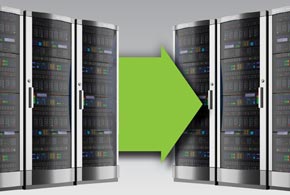
How to Successfully Migrate a Data Center
 How to Successfully Migrate a Data Center
How to Successfully Migrate a Data Center
Migrating a legacy data center to a new and updated version of itself can be a grueling task. Here are eight ways to make the process easier.
 Do Your Financial Due Diligence
Do Your Financial Due Diligence
Cost-benefit planning is essential. Determine up front the total cost of the migration, including assets and labor capital and the benefit on the other end, to determine whether the migration will prove worthwhile.
 Complete a Strategic Data Center Assessment
Complete a Strategic Data Center Assessment
Create a plan of action that starts with an in-depth, top-to-bottom inventory of IT assets, applications and dependencies.
 Consider the Cloud
Consider the Cloud
Consider a hybrid cloud strategy, which will require a cloud-readiness assessment to determine which applications can move there and includes a cost-benefit analysis of making those changes.
 Set Up the New House
Set Up the New House
This is the stage when contracts are negotiated, including: Plans for the data center space, Telecom and network infrastructure, Power structure cabling design and installation, Cloud connectivity measures
 Assign an Internal Project Team
Assign an Internal Project Team
Create a project team that includes an executive steering committee to oversee the migration and a dedicated internal IT and project management office to perform migration tasks daily for the duration of the project.
 Get Outside Help
Get Outside Help
Because data center migrations are grueling, long-term projects, they can wear out your internal staff if you go it alone. Bring in experts who do migration for a living and to balance the workload.
 Executing Your Strategy
Executing Your Strategy
To implement your strategy, start with bite-size chunks. Formulate “move groups,” with each responsible for a piece of the overall migration. Once you see a pattern of successful moves, work up to more critical changes according to your strategic plan.
 Consider Maturity Options
Consider Maturity Options
Acknowledge that every business has a different level of IT maturity. Put data you collected, inventory of your assets and dependencies, information collected through interviews, and automated scanning tools, in an IT service management tool.